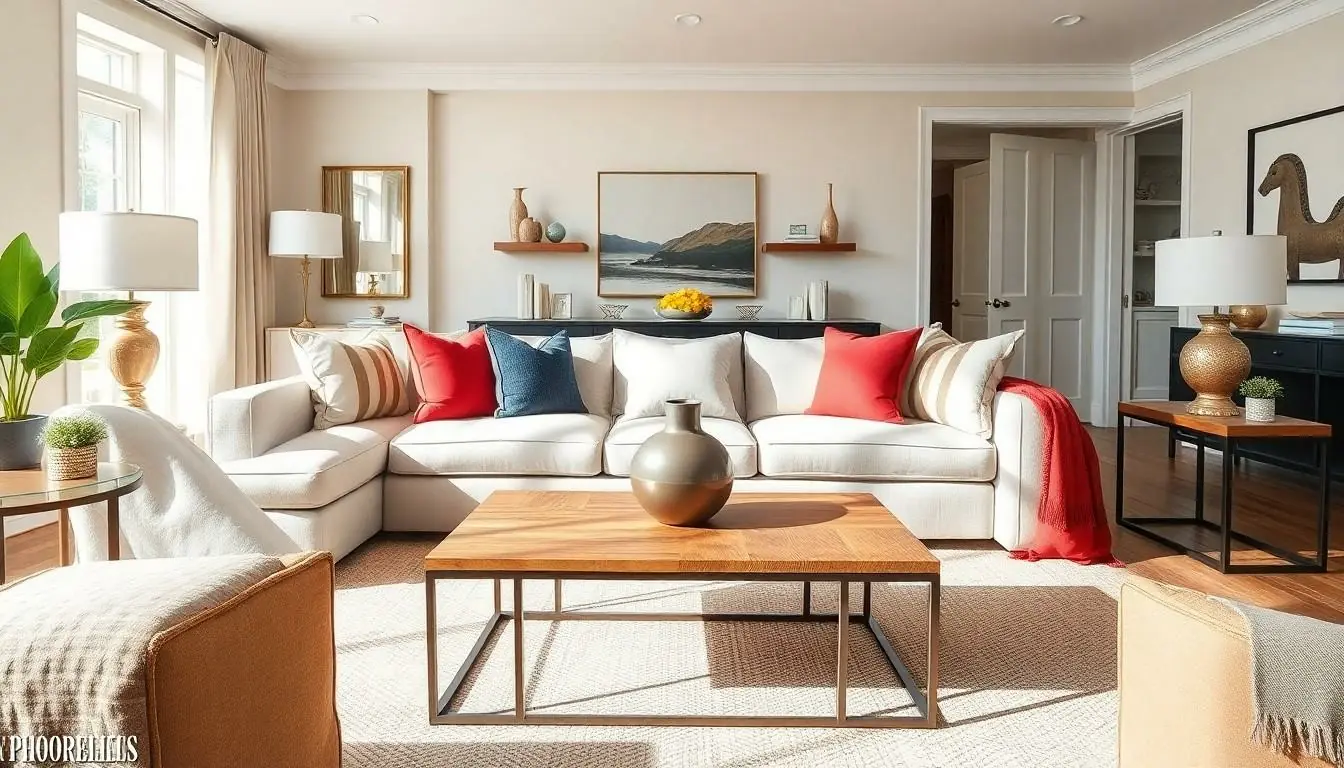Imagine a living room that effortlessly blends the classic charm of traditional design with the sleek appeal of modern aesthetics. Welcome to the world of transitional style interior design, where elegance meets comfort and every corner tells a story. This approach isn’t just a trend; it’s a lifestyle choice that invites warmth and sophistication into any home.
Transitional style is like the perfect cup of coffee—bold yet smooth, familiar yet exciting. It embraces the best of both worlds, allowing homeowners to showcase personal flair without sacrificing functionality. Whether it’s mixing textures or playing with colors, this design style offers endless possibilities. Get ready to transform your living space into a harmonious retreat that feels both timeless and fresh.
Table of Contents
ToggleOverview of Transitional Style
Transitional style interior design blends traditional and modern elements, creating a refined living space that exudes warmth and sophistication. This style allows for personal expression while maintaining functionality.
Key Characteristics
Transitional style showcases elegance and comfort through its seamless integration of various design elements. Clean lines and understated furnishings distinguish this style, creating a visually appealing balance. Mixing diverse textures, like soft fabrics and sleek metals, enhances depth in design. Open spaces invite light, fostering a welcoming atmosphere. Neutral tones often dominate, allowing for flexibility in decor. Transitional interiors incorporate classic pieces alongside contemporary ones, ensuring harmonious coexistence.
Color Palette
Transitional style primarily embraces a neutral color palette, consisting of whites, beiges, and grays. Accents can create visual interest, using muted tones or bolder hues strategically. These colors serve as a backdrop, allowing for the accentuation of furniture and decor. Earthy colors, like olive green or soft blues, also complement the overall aesthetic. Layering different shades adds complexity without overwhelming the senses. The thoughtful use of color creates a sophisticated environment that remains timeless and inviting.
Furniture Choices

In transitional style interior design, selecting the right furniture plays a crucial role in achieving balance and sophistication. Choices should reflect a mix of modern and traditional elements that create a comfortable yet elegant living space.
Sofas and Seating
Comfort and style converge in transitional sofas. Often, they feature clean lines paired with soft, inviting fabrics such as linen or velvet. Consider incorporating neutral tones for versatility, allowing accent colors to shine through pillows or throws. Adding a few accent chairs enhances depth while providing additional seating. Stylish armchairs with understated patterns maintain the elegant ambiance without overwhelming the eye.
Coffee Tables and Accents
Coffee tables serve as functional and decorative focal points. Choose designs with mixed materials like wood and metal to reinforce the transitional aesthetic. Low-profile tables offer a contemporary feel, while those with rounded edges can soften sharp lines in the room. Including accent tables alongside seating allows for flexibility and enhances usability. Accessorize these tables with minimalistic decor pieces, such as a simple vase or a stack of art books, to keep the space inviting and uncluttered.
Decor Elements
Decor elements in transitional style focus on harmony and balance. They blend classic and contemporary features, enhancing the living room’s inviting atmosphere.
Artwork and Wall Decor
Art pieces in transitional design often reflect both traditional and modern influences. Large paintings or elegant sculptures serve as focal points, creating visual interest. A gallery wall can showcase a mix of framed art and photographs, allowing for personal expression. Wall decor, like mirrors, amplifies light and depth while providing functionality. Opting for neutral frames complements the overall palette, ensuring the decor remains cohesive and attractive.
Textiles and Patterns
Textiles contribute greatly to the tactile quality of transitional interiors. Balanced combinations of textures enhance warmth, inviting comfort. Plush area rugs in subtle patterns anchor the space while adding softness underfoot. Curtains in light fabrics, such as linen or cotton, enrich the ambiance without overwhelming the design. Accent cushions with geometric or floral prints create pops of color and interest, emphasizing the transitional focus on mixing styles.
Lighting in Transitional Designs
Lighting plays a crucial role in transitional style interior design. It enhances the atmosphere and complements the aesthetic, making spaces feel inviting and polished.
Types of Lighting Fixtures
Chandeliers serve as elegant statement pieces in transitional spaces. Pendant lights offer versatility and can be used above dining areas or kitchen islands. Table lamps provide warmth and create cozy reading nooks, while floor lamps add height and definition. Wall sconces contribute to layered lighting, allowing for various intensity levels. A blend of these fixtures helps achieve balance and enhances the style’s sophisticated charm.
Natural Light Integration
Natural light significantly influences the transitional interior. Large windows support an airy feel, inviting the outdoors inside. Skylights can brighten dark corners and add visual interest. Light-colored window treatments allow sunlight to filter through while maintaining privacy. A thoughtful layout embraces open spaces and showcases light’s movement throughout the day. These strategies promote a warm, welcoming environment that’s both functional and aesthetically pleasing.
Practical Tips for Designing a Transitional Living Room
Transitional living rooms benefit from careful design choices that create a balanced atmosphere. Consider factors like space planning and the harmony between modern and traditional elements.
Space Planning Considerations
Space planning forms the foundation of a successful transitional living room. Focus on creating an open layout that encourages movement and flow. Arrange furniture to facilitate conversation while maintaining accessibility to key areas. Include ample seating options, such as a cozy sofa and accent chairs, to accommodate gatherings. Ensure pathways remain unobstructed for safety and convenience. Consider placing a focal point, like a coffee table, centrally to anchor the arrangement. Utilize rugs to define spaces while adding warmth. Position artwork and decor to enhance visual interest without overwhelming the space.
Balancing Modern and Traditional Elements
Balancing modern and traditional elements elevates the transitional design. Introduce sleek, contemporary furniture alongside classic pieces for visual contrast. Select a neutral color palette as a base to create cohesion among disparate styles. Opt for textiles that mix patterns and textures to add depth and warmth. Choose decorative accents that reference both eras like vintage lamps or modern sculptures. Incorporate familiar motifs through accessories, such as geometric cushions or traditional throws. This synergy strengthens the overall aesthetic, resulting in a sophisticated yet inviting living room.
Transitional style interior design offers a unique blend of sophistication and comfort that appeals to many homeowners. Its versatility allows for a personal touch while maintaining a cohesive look. By focusing on clean lines and thoughtful layering of textures and colors, anyone can create a living room that feels both inviting and stylish.
Emphasizing the balance between traditional and modern elements enriches the overall aesthetic. With the right furniture, decor, and lighting choices, a transitional living room can become a timeless retreat that reflects individual taste. This design style not only enhances the visual appeal but also fosters an atmosphere of warmth and welcome, making it a perfect choice for any home.



